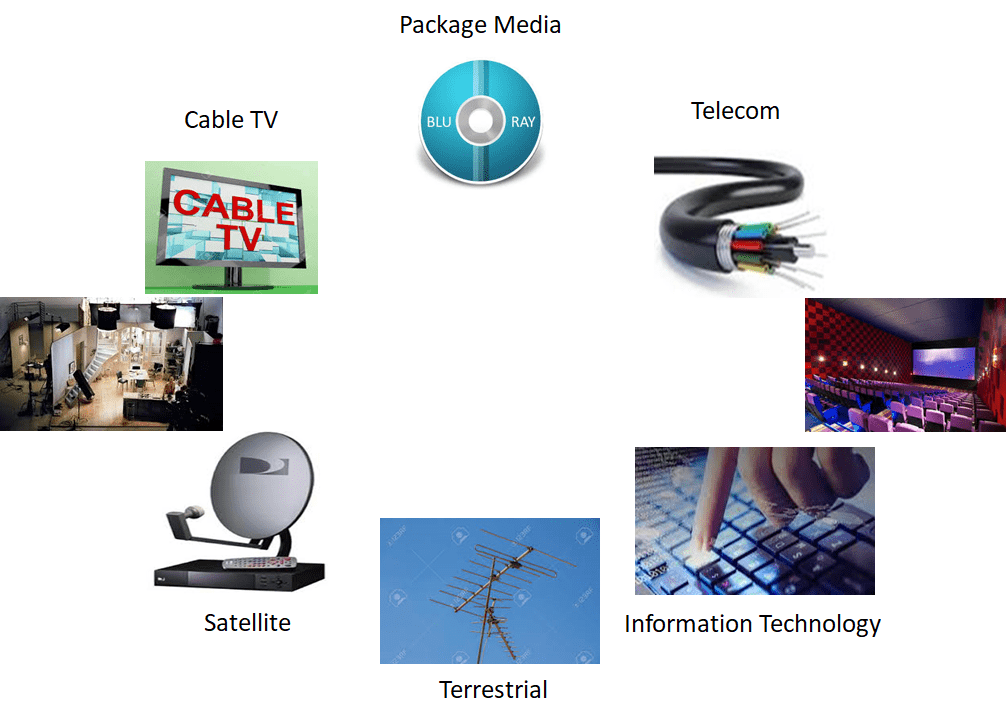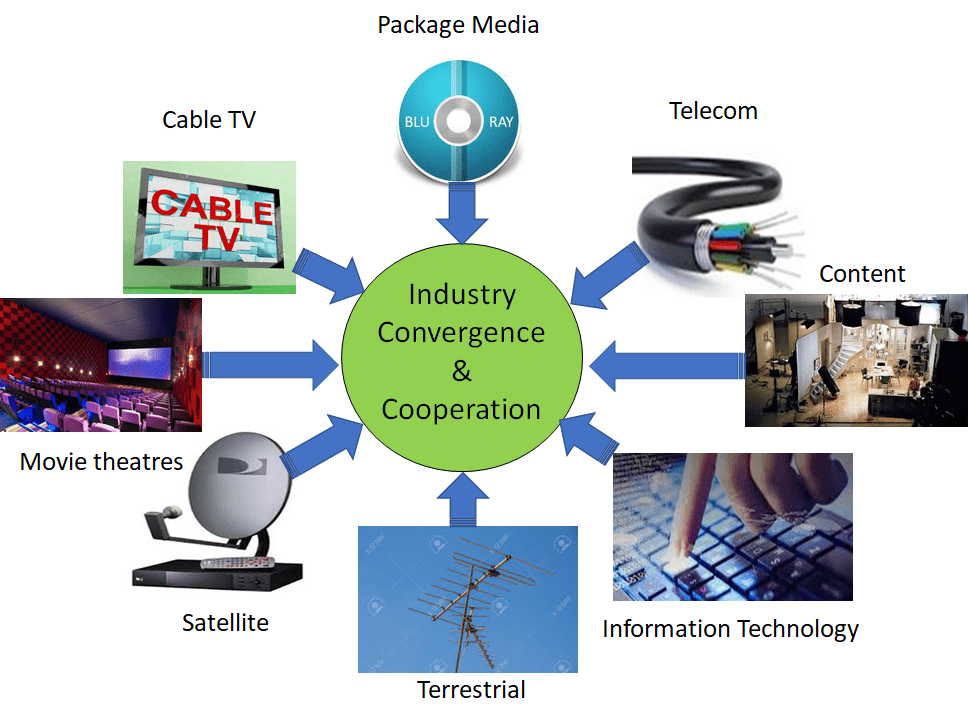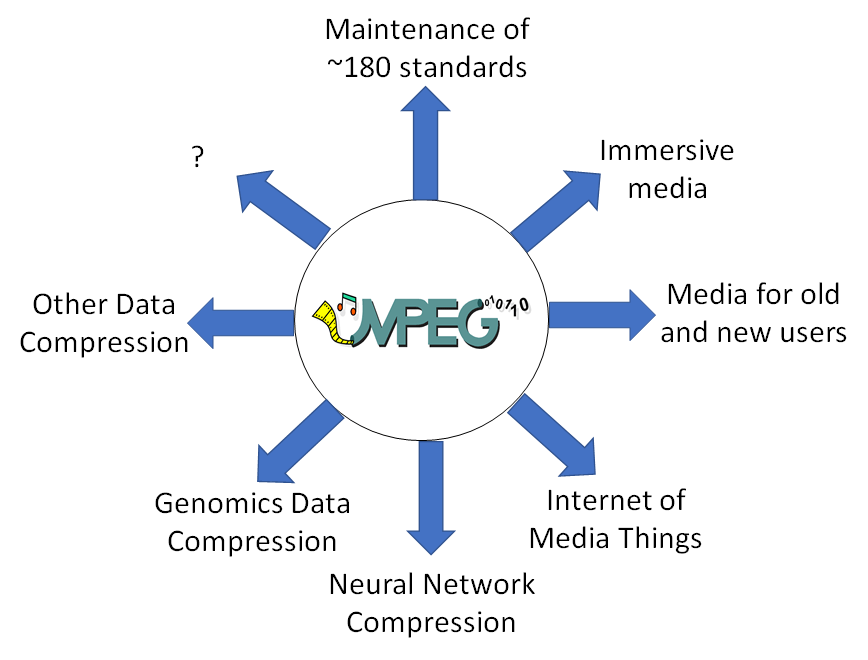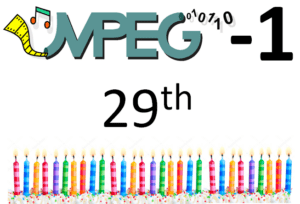MPEG was established as an experts group on 1988/01/22 in Copenhagen, a little more that 32 tears ago. At that time, content media were already very important: voice communication; vinyl, compact cassettes, compact discs for audio; radio, mostly on terrestrial Hertzian channels; and television on 4 physical media: terrestrial Hertzian channels, satellite, cable and package media.
The way individual media evolved was a result of the technology adopted to represent content media and the way content media were distributed. Industry shared some elements of the technologies but each industry introduced many differences. The situation was further exacerbated by different choice made by different countries and regions, sometimes justified by the fact that some countries introduced a technology earlier (like 415 lines of UK TV before WW II and 525 lines od US TV some years later). In some other cases there was no justification at all.
The figure below represents the actors of 1988:
- Two forms of wireless radio and television (terrestrial and satellite)
- Wired radio and television (cable)
- Physical distribution (package media)
- Theatrical movies distribution
- Content industry variously interconnected with the distribution industries.

The figure includes also two industries who, at that time, did not have an actual business in content distribution. Telecommunications was actively vying for a future role (although at that time some telcos were running cable television services as a separate business from telephony both as public services). The second industry was information technology. Few at that time expected that the internet protocol, an outcome of the information technology industry because it was designed to enable computers to communicate, would become the common means to transport media. However, eventually that is what it did.
The figure should be more articulated. Indeed it does not include manufacturers. At that time consumer electronics served users of the broadcasting service but broadcasting had their own manufacturing industry for the infrastructure. Consumer electronics was by itself the package media industry. Telcos had a manufacturing industry of their own for the infrastructure and a separate manufacturing industry for terminal devices, with some consumer electronics or office equipment companies providing facsimile terminals.
Even though it did not happen overnight, MPEG came, saw and unified. Today all the industries in the figure maintain a form of individual existence but they are much more integrated, as represented by the figure below.

Industry convergence has become a much abused word. However, it is true that standard and efficient digital media have enabled the industries to achieve enormous savings in moving to digital, and expanding from it, by allowing reuse of common components possibly form hitherto remote industries. A notable example is Media Transport (MMT) which provides the means to seamlessly move from one-way to two-way media distribution because IP is the underlying common protocol.
There is a net result from convergence that can be described as two points
- Industry: MPEG-enabled products (devices) & services are worth 1.5 T$ p.a., i.e. ~1.8% Gross World Product
- Consumers: Billions of consumers enjoy media every time and everywhere.
It would be silly to claim that this is a result for which MPEG is the only one to claim merit. There are many other standards bodies/committees who share in this result. The figure below shows some of them. It should be cleat, however, that, all started from MPEG while other bodies took over from where MPEG has left the technology.

Two words about the semantics of the figure. A black line without arrows signifies that MPEG is in liaison with the body. A black line with one arrow means that MPEG is providing or has provided standards to that body. A black line with two arrows means that the interchange is/has been two way. Finally a red line means that MPEG has actually developed standards with that body. The numbers refer to the number of jointly developed standards. The number after the + indicates the number of standards MPEG is currently developing jointly with that body.
Is there a reason why MPEG has succeeded? Probably more than one, but primarily I would like to mention one: MPEG has created standards for interoperability where industry used to develop standards for barriers. Was MPEG unique in its driving thoughts? No, it just applied the physiocratic principle “laissez faire, laissez passer” (let them do, let them pass), without any ideological connotation. Was MPEG unique in how it did it? Yes, because it first applied the principle to media standard. Was MPEG unique in its result? Yes. It created a largely homogeneous industry in what used to be scattered and compartmentalised industries.
It is easy to look at the success of the past. It is a nice exercise to do when you have reached the end of the path, but this is not the case of MPEG. Indeed MPEG has a big challenge: after it has done the impossible, people expects to do even better in the future. And MPEG has better not fail 🙁
The figure below depicts some of the challenges MPEG faces in the next few years.

A short explanation of the 8 areas of the figure:
- Maintenance of ~180 standards is what MPEG needs to do primarily. Industry has adopted MPEG standards by the tens, but that is not the end point, that is the start. Industry continuously expresses needs that come from the application of MPEG standards it has adopted. These requests must be attended to.
- Immersive media is one of the biggest challenges faced by MPEG. We all wish to have immersive experience like being physically here but feeling like we were at a different place subject to the experiences felt by those who are in that place. The challenges are immense. Addressing them requires a level on integration with the industry never seen before.
- Media for old and new users conveys two notions. The first that “old” media are not going to die anytime soon. We will need conventional audio, good old 2D rectangular video and, even though it is hard to call them as “old media”, point clouds. These media are for human users, but we see the appearance of a new type of user – machines – that are going to make use of audio and visual information that has been transmitted from remote. This goal includes the current Video Coding for Machines (VCM) exploration.
- Internet of Media Things is a standard that MPEG has already developed with the acronym IoMT. At this moment, however, this is more at the level of a basic infrastructure on which it will be possible to build support for such ambitious scenarios as Video Coding for Machines where media information is captured and processes by a network of machines assembled or built to achieve a predetermined goal.
- Neural Network Compression (NNR) is another component of the same scenario. The current assumption is that in the future a lot, if not all, of the “traditional” processing, e.g. for feature extraction, will accomplished using neural network and that components of “intelligence” will be distributed to devices, e.g. handheld devices but also IoMTs, to enable them to be a better or a new job. NNR is at its infancy in MPEG and much more from it can be expected.
- Genomic Data Compression has been shown to be viable by the MPEG-G standard. The notion of a single representation of a given type of data is a given in MPEG and has been the foundation of its success. That notion is alien to the genomic world where different data formats are applied at different portions of genomic workflows, but its application will have beneficial effects as much as it had to the media industry.
- Other Data Compression is a vast field that includes all cases where data, possibly already in digital form, are currently handled in an inefficient way. Data compression is not important only because it reduces storage and transmission time/bandwidth requirements, but because it provides data in a structured form that is suitable for further processing. Exploring and handking these opportunities is a long-term effort and will certainly provide rewarding opportunities.
- Finally, we should realise that, although MPEG holds the best compression and transport experts from the top academic and economic enterprises, we do not know the needs of all economic players. We should be constantly on alert, ready to detect the weak signal of today that will become mainstream tomorrow.
For as many years to come as it is possible to forecast today, industry and consumers will need MPEG standards.
Posts in next thread
Posts in this thread
- The impact of MPEG on the media industry
- MPEG standards, MPEG software and Open Source Software
- The MPEG Metamorphoses
- National interests, international standards and MPEG
- Media, linked media and applications
- Standards and quality
- How to make standards adopted by industry
- MPEG status report (Jan 2020)
- MPEG, 5 years from now
- Finding the driver of future MPEG standards
- The true history of MPEG’s first steps
- Put MPEG on trial
- An action plan for the MPEG Future community
- Which company would dare to do it?
- The birth of an MPEG standard idea
- More MPEG Strengths, Weaknesses, Opportunities and Threats
- The MPEG Future Manifesto
- What is MPEG doing these days?
- MPEG is a big thing. Can it be bigger?
- MPEG: vision, execution,, results and a conclusion
- Who “decides” in MPEG?
- What is the difference between an image and a video frame?
- MPEG and JPEG are grown up
- Standards and collaboration
- The talents, MPEG and the master
- Standards and business models
- On the convergence of Video and 3D Graphics
- Developing standards while preparing the future
- No one is perfect, but some are more accomplished than others
- Einige Gespenster gehen um in der Welt – die Gespenster der Zauberlehrlinge
- Does success breed success?
- Dot the i’s and cross the t’s
- The MPEG frontier
- Tranquil 7+ days of hard work
- Hamlet in Gothenburg: one or two ad hoc groups?
- The Mule, Foundation and MPEG
- Can we improve MPEG standards’ success rate?
- Which future for MPEG?
- Why MPEG is part of ISO/IEC
- The discontinuity of digital technologies
- The impact of MPEG standards
- Still more to say about MPEG standards
- The MPEG work plan (March 2019)
- MPEG and ISO
- Data compression in MPEG
- More video with more features
- Matching technology supply with demand
- What would MPEG be without Systems?
- MPEG: what it did, is doing, will do
- The MPEG drive to immersive visual experiences
- There is more to say about MPEG standards
- Moving intelligence around
- More standards – more successes – more failures
- Thirty years of audio coding and counting
- Is there a logic in MPEG standards?
- Forty years of video coding and counting
- The MPEG ecosystem
- Why is MPEG successful?
- MPEG can also be green
- The life of an MPEG standard
- Genome is digital, and can be compressed
- Compression standards and quality go hand in hand
- Digging deeper in the MPEG work
- MPEG communicates
- How does MPEG actually work?
- Life inside MPEG
- Data Compression Technologies – A FAQ
- It worked twice and will work again
- Compression standards for the data industries
- 30 years of MPEG, and counting?
- The MPEG machine is ready to start (again)
- IP counting or revenue counting?
- Business model based ISO/IEC standards
- Can MPEG overcome its Video “crisis”?
- A crisis, the causes and a solution
- Compression – the technology for the digital age

